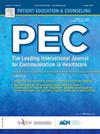癌症患者决策的详细可能性模型方法:社交媒体使用,提供者讨论和错误信息感知的作用
IF 3.1
2区 医学
Q2 PUBLIC, ENVIRONMENTAL & OCCUPATIONAL HEALTH
引用次数: 0
摘要
虽然大多数癌症患者愿意使用社交媒体(SM)来告知医疗决策,但很少有人知道提供者的沟通如何影响他们的决策过程。目的基于精化似然模型,探讨癌症患者健康相关的SM使用如何通过中心(临床讨论)和外围途径(个人对SM信息质量的印象)对其决策产生影响。方法选取具有全国代表性的健康信息全国趋势调查(HINTS, Cycle 6)中过去一年就诊并使用SM的成年癌症患者813例作为样本。采用通径分析法探讨研究目的。结果约1 / 10的癌症患者做出基于sm的医疗决策(n = 82)。做出基于sm的决策的预测因素包括与供应商进行更多的讨论。51, p <; .01),更多与健康相关的SM使用(ß =。08, p = .03),对SM信息的感知不具有误导性(ß = -。14日,p & lt; . 01)。与服务提供者的讨论正向中介了SM使用对基于SM的决策的影响。与供应商的讨论与较低的SM错误信息感知相关,预测更多基于SM的决策。尽管专家建议癌症患者与其提供者讨论他们的在线信息搜索,但本研究显示,依赖SM获取健康信息的癌症患者存在潜在的确认偏差。讨论了理论和实践意义。本文章由计算机程序翻译,如有差异,请以英文原文为准。
An elaboration likelihood model approach to cancer patients’ decision-making: The role of social media use, provider discussion, and misinformation perceptions
Background
While most cancer patients are willing to use social media (SM) to inform medical decisions, little is known about how provider’s communication may inform their decision process.
Objective
Based on the Elaboration Likelihood Model, this study explored how cancer patients’ health-related SM use may have effects on their decision-making through a central (clinical discussions) and a peripheral route (personal impression of the quality of SM information).
Methods
A sample of 813 adult cancer patients who went to a doctor in the past year and had used SM were selected from the nationally representative Health Information National Trends Survey (HINTS, Cycle 6). Path analysis was used to explore the research objective.
Results
About one in ten cancer patients make SM-based medical decisions (n = 82). Predictors of making SM-based decision include more discussions with providers (ß =.51, p < .01), more health-related SM use (ß =.08, p = .03), and perceptions of SM information being not misleading (ß = −.14, p < .01). Discussion with providers positively mediated the effect of SM use on making SM-based decisions. Discussion with providers was associated with lower SM misinformation perception, predicting more SM-based decisions.
Conclusions
Despite expert recommendations for cancer patients to discuss their online information searches with their providers, this study showed a potential confirmation bias among cancer patients who depend on SM for health information. Theoretical and practical implications are discussed.
求助全文
通过发布文献求助,成功后即可免费获取论文全文。
去求助
来源期刊

Patient Education and Counseling
医学-公共卫生、环境卫生与职业卫生
CiteScore
5.60
自引率
11.40%
发文量
384
审稿时长
46 days
期刊介绍:
Patient Education and Counseling is an interdisciplinary, international journal for patient education and health promotion researchers, managers and clinicians. The journal seeks to explore and elucidate the educational, counseling and communication models in health care. Its aim is to provide a forum for fundamental as well as applied research, and to promote the study of organizational issues involved with the delivery of patient education, counseling, health promotion services and training models in improving communication between providers and patients.
 求助内容:
求助内容: 应助结果提醒方式:
应助结果提醒方式:


